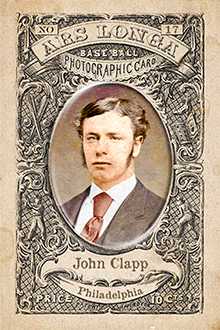
- Series: Pioneer Portraits I: 1850-1874
- City: Philadelphia
- Team: Athletics (NABBP)
- League: National Association (NAPBBP)
John Phillips Jenkins Sensenderfer (1847-1903) was a second baseman and outfielder for the Philadelphia Athletics during the first four years of the National Association of Professional Base Ball Players, from 1871-74. The debonair man with an aura of aristocracy earned his nickname at least in part from the elegant mustache he sported. The Count, a lifelong Philadelphian, had been with the club in the amateur league since 1866, making him one of the true leading lights of baseball’s earliest days. Sensenderfer hit .299 over his ML career, but injuries prevented him from approaching the outstanding batting he displayed in the Athletics’ early days in the NABBP. For example, he scored over 200 runs in 1868 as one of the most prolific of early hitters.
- After leaving baseball, Sensenderfer turned to politics. He was a local county commissioner and active in state Democratic roles as well

- Series: Pioneer Portraits I: 1850-1874
- City: Philadelphia
- Team: Athletics (NABBP)
- League: National Association (NAPBBP)
Alfred James Reach (1840-1928) “served baseball with distinction as player, organizer, club owner and provider of the equipment to attain the highest possible skill in the game” per his own Reach’s Official Base Ball Guide upon his death. “A good man, of the kindest impulses, his name will last as long as we have baseball” expressed the legacy of one of the great men of the early era of America’s game. The London-born, Brooklyn-raised Reach joked that he made the gloves he eschewed in the beginnings of the game in which he starred for the Brooklyn Eckfords and Philadelphia Athletics. He also made the AL’s balls while owning the NL Phillies franchise. A genius for marketing equipment and a lifelong love of the game made him one of the most influential figures of baseball’s first half-century.
- Began play in the amateur era, then founded the NL’s Philadelphia club in 1883
- Built the first modern ballpark in ’87, then rebuilt it with steel after a fire in ‘94
- Al's brother Bob Reach was a MLB shortstop for 3 games, 1872-1873
- Was the 88th player to debut in MLB
- Series: Pioneer Portraits I: 1850-1874
- City: Philadelphia
- Team: Athletics (NABBP)
- League: National Association (NAPBBP)
Levi Samuel Meyerle (1849-1921) came up at the inception of the national game, playing in the National Association of Base Ball Players beginning in 1867 in Philadelphia. He made quite a mark in 1871 with the Athletics, hitting an astounding, league-best .492. In ‘73 Levi joined the city’s White Stockings club then went to Chicago’s team of the same name, reconstituted after a two-year hiatus due to the Great Fire. At every stop, Meyerle was a superb hitter. Again in ‘74 he led the league in batting. Over his career in early professional ball, Levi averaged .356 in eight seasons. He was able to play all positions, even pitching a few times, but excelled at first with his 6’1” stature.
- Meyerle was praised in his era not only for his skills with the bat but for “his quiet and gentlemanly deportment”
- Levi’s .492 mark has never been exceeded in any major league

- Series: Pioneer Portraits I: 1850-1874
- City: Philadelphia
- Team: Athletics (NABBP)
- League: National Association (NAPBBP)
Fergus G. Malone (1844-1905) was a rare left-handed catcher, perhaps the first in major-league history (Bill Harbridge is another oft-cited contender for that title). Historians differ on what qualified then as a “major league,” but there is no doubt this Irishman was among the pioneers. He debuted with the Athletics in May, 1871 in the old National Association. A Civil War vet, Malone was a leader among his mates and was frequently tapped as “captain” or manager. He lasted in Philadelphia long enough for the new National League to form in 1876 while he was back with the Athletics. After a few seasons in the minors, Fergy got one last shot with the Union Association’s Philly Keystones in 1884 where a 19-year-old rookie named Jack Clements was starting out. Clements went on to be the most enduring and accomplished southpaw catcher in major league history.
- Fergy finished his time in pro ball managing Pennsylvania teams through 1888
- His batting average showed a downward arc probably related to the rigors of backstopping in the no-glove era: 1871 he hit .343, then .282, dropping steadily to .229 his last active season. Overall: .250
- Series: Pioneer Portraits I: 1850-1874
- City: Philadelphia
- Team: Athletics (NABBP)
- League: National Association (NAPBBP)
John Edgar Clapp (1851-1904) played for 8 teams and managed 6 over a 12 year span, beginning in the National Association with the Middletown Mansfields in 1872 and ending with the NY Gothams in ’83. Primarily a catcher, Clapp had a career BA of .283. With a lifetime 2,523 ABs, he struck out only 51 times.
- Was the first player-manager in major league history (1872)
- Jay Jaffe's JAWS system ranks John as the 88th best catcher in MLB history, just after Bubbles Hargrave and before Ed McFarland
- Earned the nickname “Honest John” after reporting a bookie’s attempted bribe to local police
- The 1881 bribe, in current dollars, amounted to @$119,000
- Fittingly, this Honest John entered police work after retirement from the game and died on the job in his hometown of Ithaca, NY




